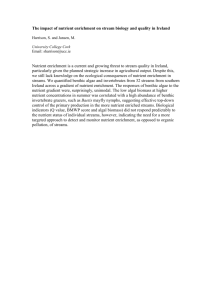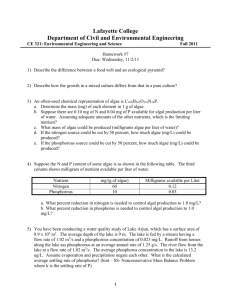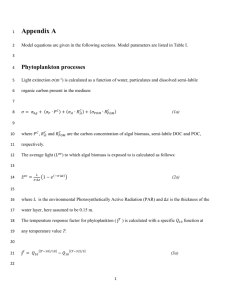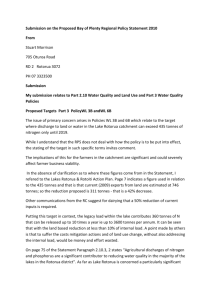Using plants (algae) to strip nutrients from streams and lakes
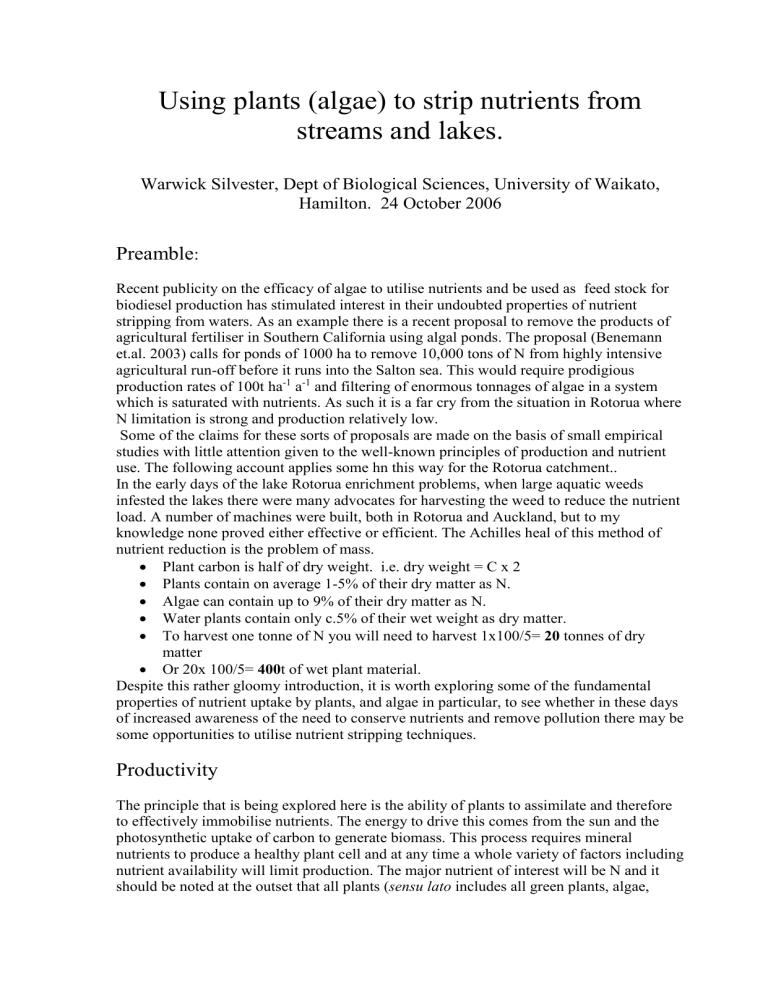
Using plants (algae) to strip nutrients from streams and lakes.
Warwick Silvester, Dept of Biological Sciences, University of Waikato,
Hamilton. 24 October 2006
Preamble
:
Recent publicity on the efficacy of algae to utilise nutrients and be used as feed stock for biodiesel production has stimulated interest in their undoubted properties of nutrient stripping from waters. As an example there is a recent proposal to remove the products of agricultural fertiliser in Southern California using algal ponds. The proposal (Benemann et.al. 2003) calls for ponds of 1000 ha to remove 10,000 tons of N from highly intensive agricultural run-off before it runs into the Salton sea. This would require prodigious production rates of 100t ha
-1
a
-1
and filtering of enormous tonnages of algae in a system which is saturated with nutrients. As such it is a far cry from the situation in Rotorua where
N limitation is strong and production relatively low.
Some of the claims for these sorts of proposals are made on the basis of small empirical studies with little attention given to the well-known principles of production and nutrient use. The following account applies some hn this way for the Rotorua catchment..
In the early days of the lake Rotorua enrichment problems, when large aquatic weeds infested the lakes there were many advocates for harvesting the weed to reduce the nutrient load. A number of machines were built, both in Rotorua and Auckland, but to my knowledge none proved either effective or efficient. The Achilles heal of this method of nutrient reduction is the problem of mass.
Plant carbon is half of dry weight. i.e. dry weight = C x 2
Plants contain on average 1-5% of their dry matter as N.
Algae can contain up to 9% of their dry matter as N.
Water plants contain only c.5% of their wet weight as dry matter.
To harvest one tonne of N you will need to harvest 1x100/5= 20 tonnes of dry matter
Or 20x 100/5= 400 t of wet plant material.
Despite this rather gloomy introduction, it is worth exploring some of the fundamental properties of nutrient uptake by plants, and algae in particular, to see whether in these days of increased awareness of the need to conserve nutrients and remove pollution there may be some opportunities to utilise nutrient stripping techniques.
Productivity
The principle that is being explored here is the ability of plants to assimilate and therefore to effectively immobilise nutrients. The energy to drive this comes from the sun and the photosynthetic uptake of carbon to generate biomass. This process requires mineral nutrients to produce a healthy plant cell and at any time a whole variety of factors including nutrient availability will limit production. The major nutrient of interest will be N and it should be noted at the outset that all plants ( sensu lato includes all green plants, algae,
fungi and bacteria) can absorb and assimilate the major inorganic forms of N both nitrate and ammonia. These inorganic forms are rapidly assimilated into proteins and as such are immobilised in cell as structures and as proteins such as chlorophyll and enzymes..
Animals are unable to do this and they must obtain their N in an already metabolised form such as proteins or amino acids. The N in plant tissue is released when the plant dies or is eaten, but while in the plant it is stable and essentially immobilised, but is available for transport or further metabolism within the organism.
The amount of nutrient that a plant will assimilate and therefore immobilise in biomass is dependent on a wide variety of factors that need to be explored to obtain a measure of the potential of the process. The primary controller is the rate of plant growth or production, which of course is controlled by photosynthetic rate.
The five controlling variables in photosynthesis are:
Plant species
Light intensity
Water
Temperature
Nutrient levels
To evaluate the potential for plant nutrient immobilisation we will review production rates for both aquatic and terrestrial ecosystems and then look at the possible limiting factors and how they control the process.
Primary production rates
Primary production [the production of net biomass (dry matter) from photosynthesis] varies from very low levels of < 1 t ha
-1
a
-1 in dry continental deserts and deep ocean nutrient-poor deserts to the very high levels of 100 t ha
-1
a
-1 in some tropical swamps and estuaries. Some algal cultivation systems have been reported to give these high levels as well.
In NZ, pasture systems can produce at least 20 t ha
-1
a
-1
while forest systems can produce at least 40 t ha -1 a -1 . Both these ecosystems are variously light, temperature, water and nutrient limited at different times of the year. When water limitation is removed by irrigation and when sufficient fertiliser is added primary production becomes light and temperature limited and can easily go above 40 t ha -1 a -1 in temperate latitudes. Such productivity could potentially immobilise over one tonne of N in plant biomass.
Lake and stream primary production is normally much lower than the above terrestrial systems and is normally nutrient limited and this gives rise to the possibility of using such systems for nutrient stripping.
Limiting Factors:
Potentially any of the factors listed above could be limiting algal production in both lakes and streams. For most of the year temperature and light are sufficient to support algal growth. However the pervading factor will be nutrients and of these it has been shown that N is the most limiting followed by P. In fact to get maximum N uptake in many of the Rotorua lakes some P needs to be added. This fact then leads to the ideal situation for nutrient stripping, algal cells will preferentially reduce N levels in these waters. Given that almost any plant material in streams and lakes will immobilise
nitrate or ammonia to cellular N, can we manage this process more effectively to reduce
N levels? Nutrient uptake will always be a function of plant growth and when growth increases so does uptake to support that growth.
The Situation in Streams:
The removal of nutrients during passage down a stream is called attenuation and covers a range of processes including physical, chemical and plant assimilation as well as (for
N) denitrification. Measurements of attenuation can be made simply by measuring flow weighted average nutrient loads upstream and downstream. For small slow flowing streams ( 0.01 – 1.0 m 3 s 1) the rates of attenuation of N may as much as 20% km
-1
while for large streams it drops to as low as 0.1% km
-1
(Alexander et al. 2002).
The role of plant uptake as a mechanism for attenuation in streams is simply modelled for streams in the Waikato catchment.
It is difficult to obtain average annual net production figures for streams in NZ.
However a general world figure of 250-1000 mg C m
-2
day
-1
for mesotrophic lakes and streams and 50-300 for eutrophic waters seems a reasonable average. Our streams are generally low in nutrients so we will take 200 mg C as an average figure this equates to
400 mg dry matter and gives:
400 mg dry weight x300 days = 120g biomass m
-2
yr
-1
( or 1200 kg ha
-1 yr
-1
)
This figure is compared to 76-124 g m -2 yr -1 measured in streams in Britain (Marker
1972).
Therefore if a stream can produce c. one tonne of biomass for every hectare of river surface then something like 5% (50kg) of that will be immobilised as cellular N.
Thus a stream that is 2km long and on average 5m wide (i.e. 10,000 m
2
or one hectare) could potentially immobilise 50 kg of N per year.
This situation applies to low nutrient situations such as the streams flowing into
Rotorua at present. In very enriched situations the uptake of N could approach twice that amount. Thus it is apparent in the strongly nutrient limited waters flowing into the
Rotorua lakes only a very small amount of N will be assimilated by benthic algae. The situation of macrophytes growing on the stream margins, as has been described in the
Taupo catchment; is different in that some of their nutrients are supplied from soil and considerably higher production rates may apply, however the stream margins represent a very small area of stream water.
Regardless of the rate of immobilisation into plant tissue, to be effective as a mechanism of reducing nutrient input to a lake, this biomass, and its attendant nitrogen and phosphorus, must be removed from the stream. For algae this presents a very difficult problem, not just the problem of wet biomass but the problems of removing cells from dilute solution or removing benthic mats from surfaces.
The potential for removing N from stream water by biological uptake depends simply on the stream area exposed, the size of stream and the consequent flow rate. At present
N levels in streams, the maximum removal rate would be in the range of 50-100 kg N per hectare of stream surface per year. As a large proportion of water flowing into Lake
Rotorua is from springs close to the lake margin the potential for this process is extremely small.
The Situation in Lakes.
Attenuation in lakes is much more difficult to measure and to model and has been estimated at up to 75% for lakes with low load ( Alexander 2002). A proper measure of the contribution of algal uptake to this attenuation requires a reliable measure of net production, which along with measures of N inputs can reveal the role of production in immobilising N. The most extensive values for production in Lake Rotorua are those of
Burnet and Davis (1980). They measured primary production over three years using the
14
C uptake method. The numbers produced from this study show Lake Rotorua to be a highly productive lake with an average net photosynthesis rate of 900g C m
-2
a
-1
.
Conversion of net photosynthesis to net production is problematic as no measures of respiration are reported so I have taken a conservative 50% of this photosynthesis as having gone into net production. Comparison with lakes around the world shows that these values, while high, are not uncommon. The range of values given in a review of the work of Likens, Schindler etc. shows lake values for primary production can range from 36 (Lake Tahoe) to 912 (Clear Lake), to 7811 g C m
-2
a
-1
(Lake Kilotes Ethiopia).
Thus a value of 450 for Lake Rotorua may not be considered out of the way. The following data derive from that production value:
•Basic data used.
1.Lake area 8000ha
2.Lake volume 8x108 m3
3.Lake mean total N content 450 mg m-3
4.*Mean net photosynthesis 900g C m-2 a-1
5.Mean net primary production 450g C m-2 a-1
6.Mean N content of algae
7.N inputs to lake
5%
600t ext +300t int=900t
Calculations 1
1.Net biomass production (Cx2=biomass). (450x2) 900 g m-2 a-1
2.Net primary production (900 x 10,000)
3.For whole lake (9x8000)
4.Wet biomass (dry x 20)
9t ha-1 a-1
72 000t a -1 dry biomass
1 440 000 t a-1
5.Algal N uptake at 5% (72 000 x 0.05)
6.Mean Lake N content (450mg x 8 x 108)
3 600t N a-1
360 t N
7.Turnover time (3600/360) 10 a-1
8.Maximum age of any algal cell (365/10) 36.5 days
Calculations 2
1.Annual N uptake
2.Annual N input to lake (ext+int)
3 600 t N
900t N
3.Four times as much N appears in algal cells during one year than is introduced by int and ext inputs
4.Of the total N uptake in one year we can apportion it as follows
•External
600t
•Recycled from sediment
•Recycled from water column
300t
2700t
•Total 3600t
While there may be some debate as to the absolute accuracy of some of the above figures there is little doubt on the orders of magnitude, that there is enormous N turnover within the lake which is something like six times greater than the currently used number of 400t from sediment. The amount of N appearing in algal biomass is three times greater than the annual input of N into the lake and the main driver of production is N recycling. This comes as no surprise but I believe the magnitude of the nutrient recycling within the lake is still not fully appreciated. Whether the N recycling is from sediment or from water column is of significance in managing sediment and in understanding the dynamics of nutrient limitation.
One of the most astounding results of this analysis is that the mean lake N content of 360t is exceeded 110 times by the amount of N taken annually into biomass giving a mean turnover time of 36.5 days.
If an efficient method of harvesting this N could be devised it could prove very effective in reducing the N content. The problem is that at any one time the amount of dry biomass in the water column is only 6g m
-3
about a teaspoon full (or 120 g wet weight).
Conclusions
The production rate and concentrations of N and of algal biomass in streams make it most unlikely that a method of N recovery could be efficient at the point of entry.
Lake N concentrations are also low but the turnover time is very rapid.
The amount of N that appears in algal biomass during a year exceeds the input rate of N by a factor of 3 and exceeds the mean water column N content by a factor of 15.
N turnover is rapid (15 a
-1
) giving an opportunity to capture a large portion of N by harvesting.
However mean N being low means that harvesting will be inefficient.
References
Alexander R.B., Elliott H., Shankar U., McBride G.B. 2002 Estimating the sources and transport of nutrients in three Waikato river basins, New Zealand. Water resources 38,
1268-1291.
Benemann J.R., van Olst J.C., Massingill M.J., Weissman J. C., Brune D.E. 2003 the controlled eutrophication process: Using microalgae for CO
2
utilisation and agricultural fertiliser recycling. http://www.unh.edu/p2/biodiesel/pdf/algae_salton_sea.pdf
Marker A.F.H. 1976. The benthic algae of some streams in southern England. II Primary production of the epilithon in a small chalk stream.
Journal of Ecology ,. 64, 359-373

